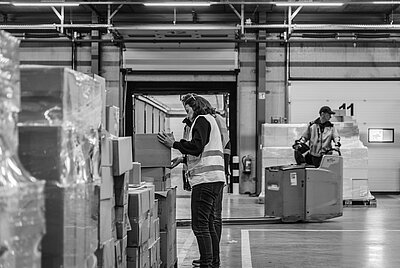Phones will become (even) more important
We already do a lot of shopping using our phones – but not so often in a physical retail location. Canadian pharmacy Well.ca is changing that by placing virtual shelves behind glass, stocked with flattened, empty packages. Customers simply scan what they want to buy and the products are delivered, just as they would be when ordering from the brand’s website.
The benefits are obvious: for consumers, it is the best parts of online and offline shopping combined, and for Well.ca, it is a quick and easy way to set up ‘stores’ without the expense of a full fit-out. It also means it can start selling products where it wouldn’t otherwise be possible, as its super slim shelving concept could be just as easily accommodated on a metro station platform or inside a lift as it would in a mall.
We are surprised not to have already seen this idea widely copied elsewhere, and suspect that whoever rolls it out could opt for an even slimmer format: printed posters rather than svelte shelves that deliver the same result.
Packaging will reduce
Now with 3,000 outlets in 65 countries, The Body Shop was, in the 1980s, one of the first retail brands to champion recycling. Anita Roddick explained, “we recycled everything, not because we were environmentally friendly but because we didn’t have enough bottles.”
It took a long time for less frugal retailers to catch on, or for consumers to sign up to the idea of minimising the environmental impact of their shopping decisions, but they did – and government-led schemes to ban plastic carrier bags has made packaging-free shopping the norm.
Expect to see brands take this further over the next decade, with a tilt towards more extensive use of environmentally responsible alternatives to traditional packaging and, in many cases, no packaging at all. Refill shops, to which consumers bring their own containers, were once niche, but are quickly becoming mainstream. Customers feel good to be doing their bit, and the stores themselves need to devote less space to packaging that is often thrown in the bin soon after purchase, leaving room for more worthwhile stock.
Even the big supermarkets are starting to take note. In the UK, Marks & Spencer, Sainsbury’s and Asda are already trialling in-store refill stations.
AI will handle the supply-side
Retail stores generate enormous amounts of data, which has long been used to help chains make more intelligent purchasing decisions. Over the coming years, those decisions will become ever-more apt through the use of alternative data. Traditionally the preserve of financial markets, alternative data comprises non-core factors, like real-world traffic, weather conditions, demographics, and trends scraped from social networks like Facebook and Twitter. These will allow retailers to position the data that they already gather in store within a wider and more relevant context.
Across a large chain, the quantity of data gathered will be so large that it can only be effectively processed in the cloud. Once there, artificial intelligence will be able to spot patterns that wouldn’t be obvious to the human eye, on the basis of which it should be able to return actionable insights on a store-by-store basis.
Alternative data won’t only help buyers identify the products most likely to sell well next year: it will also enable them to buy goods not for resale, like shelving, bags, hangers and more, in advance of the products’ arrival.
Payment options will become more diverse
Across Europe, contactless payments already make up around half of all retail transactions. In the wake of the pandemic, we feel confident predicting that, over the next few years, that number will increase significantly.
Fortunately, retailers are already well-equipped to accommodate the growth of tap-to-pay, including by mobile phone using built-in NFC chips, but they need to be alert for what comes next.
Cryptocurrency hasn’t appeared on most consumers’ radar – yet – but that is not true across the board. Electric auto maker Tesla is now accepting Bitcoin as a payment option, in a move that makes perfect sense for a brand that is more likely than most to attract tech-savvy shoppers. And it is not the only one. Starbucks and department store Nordstrom similarly allow customers to pay using the cryptocurrency.
Bitcoin is just one digital currency among many, though, and retailers are going to have to decide which – and how many – they want to support. Fortunately, this may be made easier with input from intermediaries like Visa, which is already exploring ways to work with Ethereum, one of the most popular alternatives to Bitcoin.
Real-world retail will retain its edge
Competition with online shopping will be even more fierce than it is today, but existing real-world outlets should see this as an opportunity. While it will force many retailers to become omnichannel brands, in which the distinction between their online and offline activity is blurred, a physical presence gives them an edge on purely online players. They have native showrooms, can facilitate click and collect for same day shopping without additional logistics costs, and a powerful physical manifestation that will reinforce brand recognition and fidelity without relying on SEO, newsletters and online advertising.
Online brands that want to do the same have a more difficult task ahead. Retail rents are likely to be lower, at least in the short to medium term, as portfolio managers look to fill vacant units following the pandemic, but the costs for an online brand establishing a high street presence will still be more than those for a real-world chain bolstering its online store.
It is notable that the only brand making a good show of doing so, to date, is Amazon which, despite being the world’s biggest online retailer, still has fewer than 30 real world grocery stores in its portfolio.
For advice on what trends could affect your store, speak to our team on +31 (0) 88 494 20 80 or email us at online@worldpack.eu


